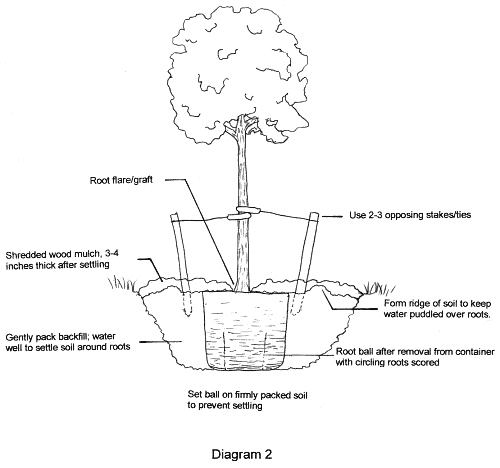Talking Plants
Jillian Patrie | University of Minnesota Yard and Garden Extension
Planting is in full swing, and late spring to early summer is a perfect time to add trees and shrubs to your landscape. Spring rains and cooler temperatures allow trees and shrubs to acclimate to their new surroundings without too much added stress. When planting there are a few things to consider ensuring a strong and healthy tree or shrub.
Choosing a location that accommodates the mature height and width is the first step. If the location is near a structure or other trees remember to plan for its mature size, “right plant, right place”. Once the location is selected, call to locate any underground or overhead utilities, and confirm the location is safe. Most trees and shrubs come in a nursery container, which has been their home for several years. Roots will start to grow in a circle while in the pot and can become a tangled mess. Before placing the root ball into the hole, straighten out roots that may be crossing over others, or remove them. Breaking up the root ball with a spade (making sure not to injure the roots too much) can help. This is also important for shrubs and other plants too. Gently breaking up the root ball can encourage new root growth and space for air and water. When it is time to plant, the hole should be dug 2x the width of the container the plant is in, to allow roots to establish. It is important to avoid digging the hole too deep, the tree root flare (where the trunk widens into roots) should be visible above the soil line. It may be necessary to remove soil from the top of the root ball to locate the root flare. Planting trees too deep can cause several issues later in the tree’s life. Shrubs can be planted at the depth of the root ball, and locating the root flare is not necessary.
After planting the tree at the correct depth, replace native soil and the container back into the hole. Pack down firmly and water with 5-7 gallons of water. Depending on rainfall, temperature and wind, watering may occur 2 times a week. You may also trickle a hose at the base of the tree or shrub (determine how much time it takes to put on 5-7 gallons of water). Watering deeply is key, and sprinklers are not a sufficient way to water trees.
Transplant shock is real, and trees may wilt or even drop leaves shortly after planting. This is especially true when the weather is hot and windy. Keep watering on a schedule (1-2 a week) and deeply. Checking the soil 4-8” down to assess the soil moisture. Clay soils will hold water longer than others, overwatering can occur even though it looks like the tree is thirsty. To avoid added stress caused by heat, avoid planting new trees or shrubs when weather conditions are hot and dry.
Mulching trees after planting can help retain moisture, keep mowers, and weeds away. Add a ring of mulch 2” thick and 3-4’ wide around newly planted trees. Keep mulch away from the trunk and avoid creating a “mulch volcano”. If staking is necessary for stabilization while the new tree grows roots, remember to remove them after one year.
For more information on planting trees and shrubs visit: https://extension.umn.edu/how/planting-and-transplanting-trees-and-shrubs or contact your local Clay County Extension Educator Jill Patrie at patri350@umn.edu or by phone at 218-299-7338.


